Ming Wang
REPAIR: Robust Editing via Progressive Adaptive Intervention and Reintegration
Oct 02, 2025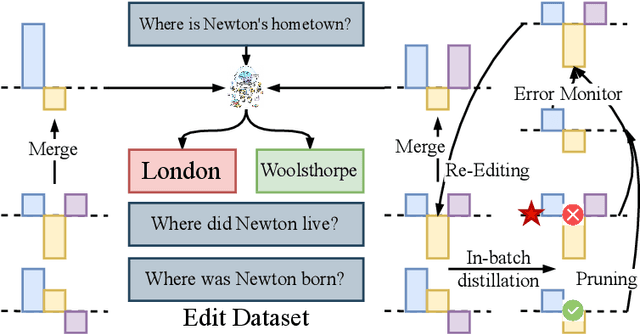
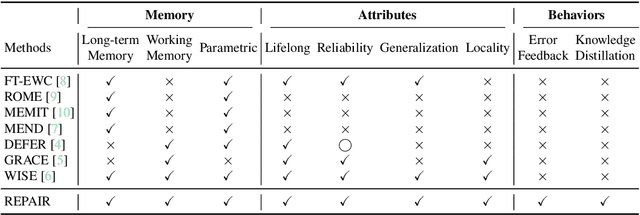
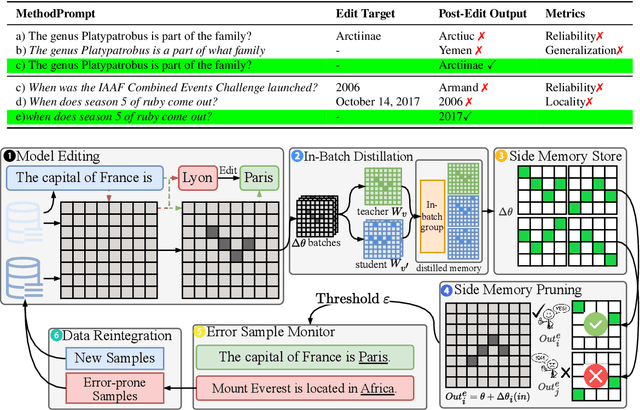
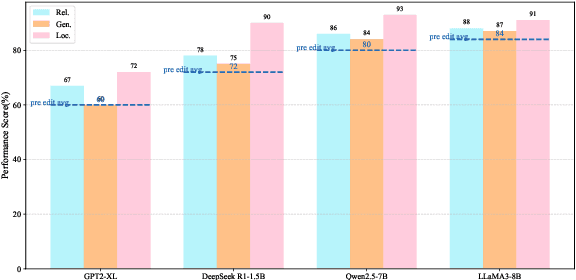
Abstract:Post-training for large language models (LLMs) is constrained by the high cost of acquiring new knowledge or correcting errors and by the unintended side effects that frequently arise from retraining. To address these issues, we introduce REPAIR (Robust Editing via Progressive Adaptive Intervention and Reintegration), a lifelong editing framework designed to support precise and low-cost model updates while preserving non-target knowledge. REPAIR mitigates the instability and conflicts of large-scale sequential edits through a closed-loop feedback mechanism coupled with dynamic memory management. Furthermore, by incorporating frequent knowledge fusion and enforcing strong locality guards, REPAIR effectively addresses the shortcomings of traditional distribution-agnostic approaches that often overlook unintended ripple effects. Our experiments demonstrate that REPAIR boosts editing accuracy by 10%-30% across multiple model families and significantly reduces knowledge forgetting. This work introduces a robust framework for developing reliable, scalable, and continually evolving LLMs.
DIFNet: Decentralized Information Filtering Fusion Neural Network with Unknown Correlation in Sensor Measurement Noises
Aug 26, 2025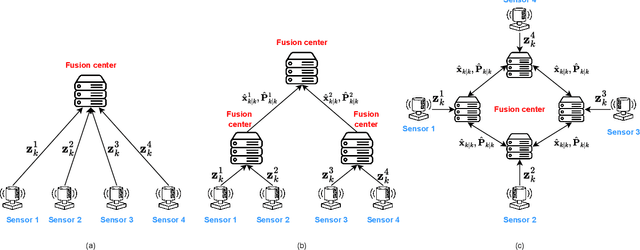
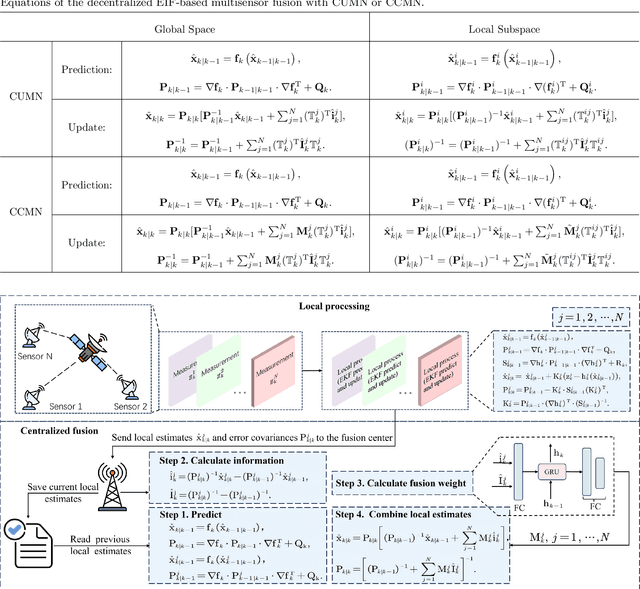
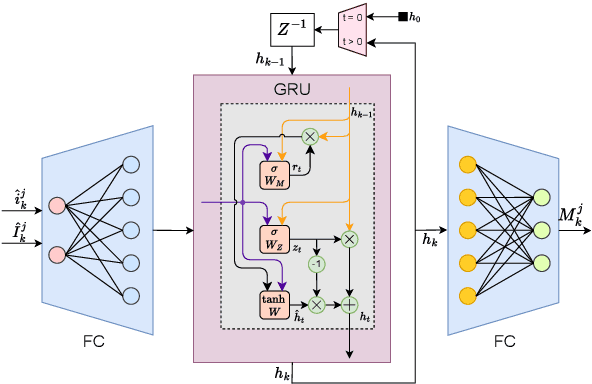
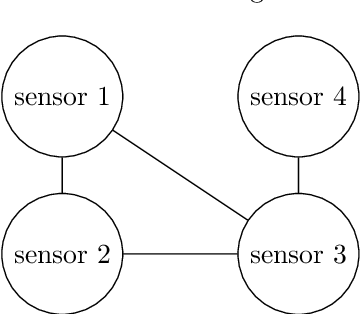
Abstract:In recent years, decentralized sensor networks have garnered significant attention in the field of state estimation owing to enhanced robustness, scalability, and fault tolerance. Optimal fusion performance can be achieved under fully connected communication and known noise correlation structures. To mitigate communication overhead, the global state estimation problem is decomposed into local subproblems through structured observation model. This ensures that even when the communication network is not fully connected, each sensor can achieve locally optimal estimates of its observable state components. To address the degradation of fusion accuracy induced by unknown correlations in measurement noise, this paper proposes a data-driven method, termed Decentralized Information Filter Neural Network (DIFNet), to learn unknown noise correlations in data for discrete-time nonlinear state space models with cross-correlated measurement noises. Numerical simulations demonstrate that DIFNet achieves superior fusion performance compared to conventional filtering methods and exhibits robust characteristics in more complex scenarios, such as the presence of time-varying noise. The source code used in our numerical experiment can be found online at https://wisdom-estimation.github.io/DIFNet_Demonstrate/.
Artificial Intelligence-Based Multiscale Temporal Modeling for Anomaly Detection in Cloud Services
Aug 20, 2025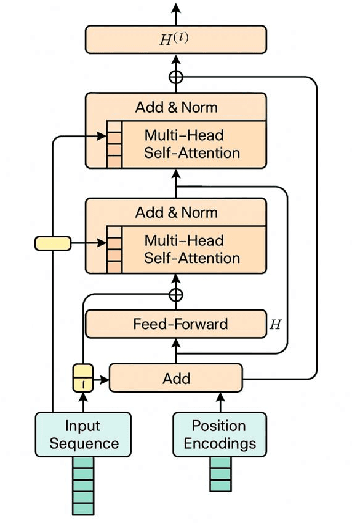
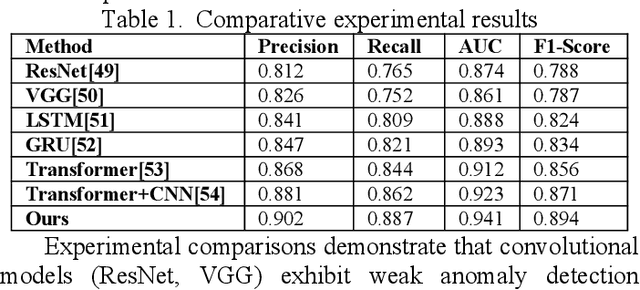
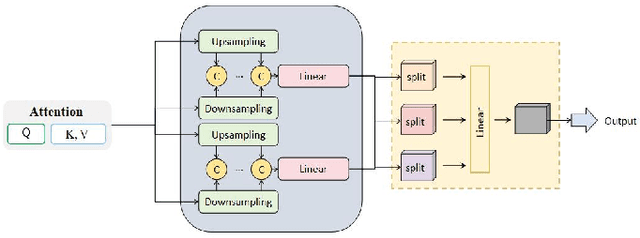
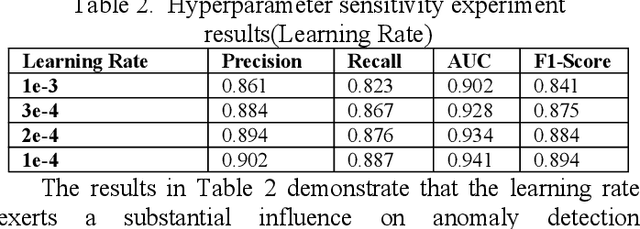
Abstract:This study proposes an anomaly detection method based on the Transformer architecture with integrated multiscale feature perception, aiming to address the limitations of temporal modeling and scale-aware feature representation in cloud service environments. The method first employs an improved Transformer module to perform temporal modeling on high-dimensional monitoring data, using a self-attention mechanism to capture long-range dependencies and contextual semantics. Then, a multiscale feature construction path is introduced to extract temporal features at different granularities through downsampling and parallel encoding. An attention-weighted fusion module is designed to dynamically adjust the contribution of each scale to the final decision, enhancing the model's robustness in anomaly pattern modeling. In the input modeling stage, standardized multidimensional time series are constructed, covering core signals such as CPU utilization, memory usage, and task scheduling states, while positional encoding is used to strengthen the model's temporal awareness. A systematic experimental setup is designed to evaluate performance, including comparative experiments and hyperparameter sensitivity analysis, focusing on the impact of optimizers, learning rates, anomaly ratios, and noise levels. Experimental results show that the proposed method outperforms mainstream baseline models in key metrics, including precision, recall, AUC, and F1-score, and maintains strong stability and detection performance under various perturbation conditions, demonstrating its superior capability in complex cloud environments.
DesignBench: A Comprehensive Benchmark for MLLM-based Front-end Code Generation
Jun 06, 2025
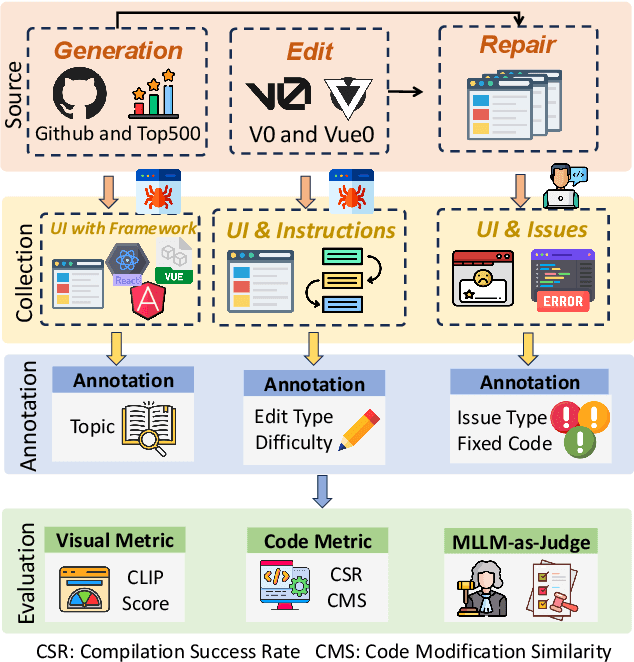

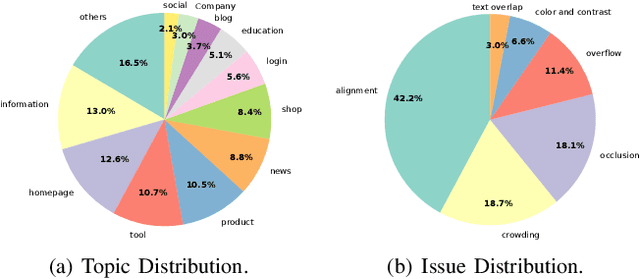
Abstract:Multimodal Large Language Models (MLLMs) have demonstrated remarkable capabilities in automated front-end engineering, e.g., generating UI code from visual designs. However, existing front-end UI code generation benchmarks have the following limitations: (1) While framework-based development becomes predominant in modern front-end programming, current benchmarks fail to incorporate mainstream development frameworks. (2) Existing evaluations focus solely on the UI code generation task, whereas practical UI development involves several iterations, including refining editing, and repairing issues. (3) Current benchmarks employ unidimensional evaluation, lacking investigation into influencing factors like task difficulty, input context variations, and in-depth code-level analysis. To bridge these gaps, we introduce DesignBench, a multi-framework, multi-task evaluation benchmark for assessing MLLMs' capabilities in automated front-end engineering. DesignBench encompasses three widely-used UI frameworks (React, Vue, and Angular) alongside vanilla HTML/CSS, and evaluates on three essential front-end tasks (generation, edit, and repair) in real-world development workflows. DesignBench contains 900 webpage samples spanning over 11 topics, 9 edit types, and 6 issue categories, enabling detailed analysis of MLLM performance across multiple dimensions. Our systematic evaluation reveals critical insights into MLLMs' framework-specific limitations, task-related bottlenecks, and performance variations under different conditions, providing guidance for future research in automated front-end development. Our code and data are available at https://github.com/WebPAI/DesignBench.
EvidenceBench: A Benchmark for Extracting Evidence from Biomedical Papers
Apr 25, 2025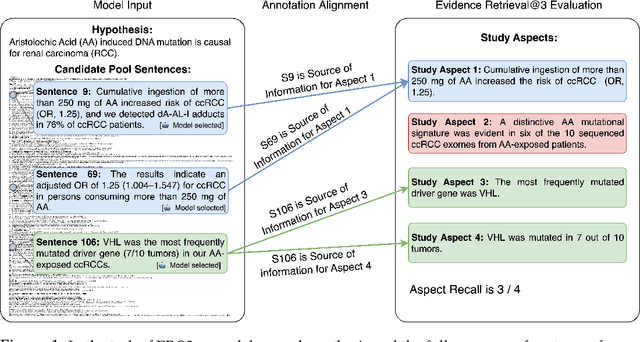

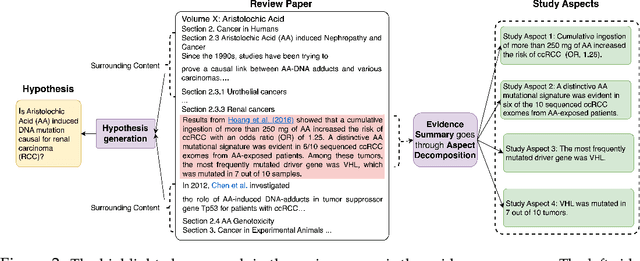

Abstract:We study the task of automatically finding evidence relevant to hypotheses in biomedical papers. Finding relevant evidence is an important step when researchers investigate scientific hypotheses. We introduce EvidenceBench to measure models performance on this task, which is created by a novel pipeline that consists of hypothesis generation and sentence-by-sentence annotation of biomedical papers for relevant evidence, completely guided by and faithfully following existing human experts judgment. We demonstrate the pipeline's validity and accuracy with multiple sets of human-expert annotations. We evaluated a diverse set of language models and retrieval systems on the benchmark and found that model performances still fall significantly short of the expert level on this task. To show the scalability of our proposed pipeline, we create a larger EvidenceBench-100k with 107,461 fully annotated papers with hypotheses to facilitate model training and development. Both datasets are available at https://github.com/EvidenceBench/EvidenceBench
DeFine: A Decomposed and Fine-Grained Annotated Dataset for Long-form Article Generation
Mar 10, 2025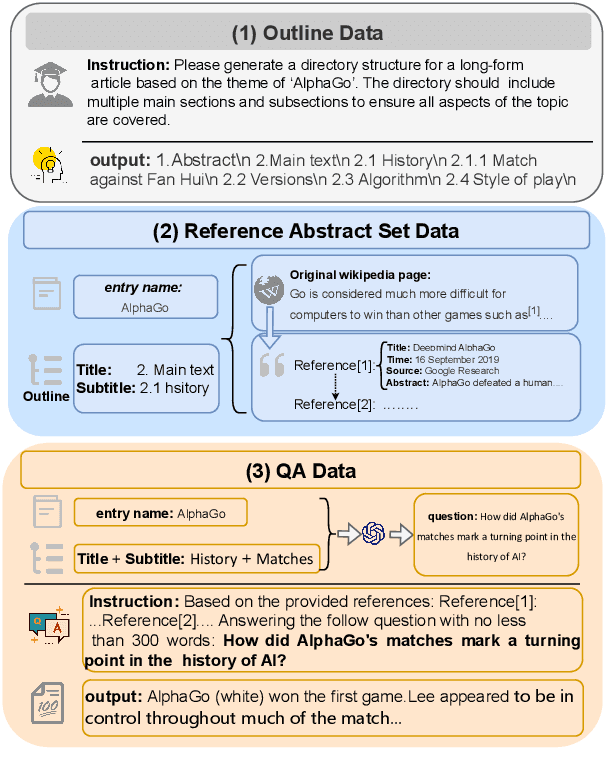

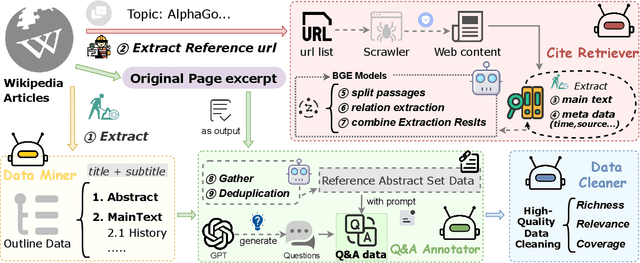

Abstract:Long-form article generation (LFAG) presents challenges such as maintaining logical consistency, comprehensive topic coverage, and narrative coherence across extended articles. Existing datasets often lack both the hierarchical structure and fine-grained annotation needed to effectively decompose tasks, resulting in shallow, disorganized article generation. To address these limitations, we introduce DeFine, a Decomposed and Fine-grained annotated dataset for long-form article generation. DeFine is characterized by its hierarchical decomposition strategy and the integration of domain-specific knowledge with multi-level annotations, ensuring granular control and enhanced depth in article generation. To construct the dataset, a multi-agent collaborative pipeline is proposed, which systematically segments the generation process into four parts: Data Miner, Cite Retreiver, Q&A Annotator and Data Cleaner. To validate the effectiveness of DeFine, we designed and tested three LFAG baselines: the web retrieval, the local retrieval, and the grounded reference. We fine-tuned the Qwen2-7b-Instruct model using the DeFine training dataset. The experimental results showed significant improvements in text quality, specifically in topic coverage, depth of information, and content fidelity. Our dataset publicly available to facilitate future research.
Benchmarking Post-Training Quantization in LLMs: Comprehensive Taxonomy, Unified Evaluation, and Comparative Analysis
Feb 18, 2025Abstract:Post-training Quantization (PTQ) technique has been extensively adopted for large language models (LLMs) compression owing to its efficiency and low resource requirement. However, current research lacks a in-depth analysis of the superior and applicable scenarios of each PTQ strategy. In addition, existing algorithms focus primarily on performance, overlooking the trade-off among model size, performance, and quantization bitwidth. To mitigate these confusions, we provide a novel benchmark for LLMs PTQ in this paper. Firstly, in order to support our benchmark, we propose a comprehensive taxonomy for existing mainstream methods by scrutinizing their computational strategies (e.g., optimization-based, compensation-based, etc.). Then, we conduct extensive experiments with the baseline within each class, covering models with various sizes (7B-70B), bitwidths, training levels (LLaMA1/2/3/3.1), architectures (Mixtral, DeepSeekMoE and Mamba) and modality (LLaVA1.5 and VILA1.5) on a wide range of evaluation metrics.Through comparative analysis on the results, we summarize the superior of each PTQ strategy and modelsize-bitwidth trade-off considering the performance. For example, our benchmark reveals that compensation-based technique demonstrates outstanding cross-architecture robustness and extremely low-bit PTQ for ultra large models should be reexamined. Finally, we further accordingly claim that a practical combination of compensation and other PTQ strategy can achieve SOTA various robustness. We believe that our benchmark will provide valuable recommendations for the deployment of LLMs and future research on PTQ approaches.
PTQ1.61: Push the Real Limit of Extremely Low-Bit Post-Training Quantization Methods for Large Language Models
Feb 18, 2025
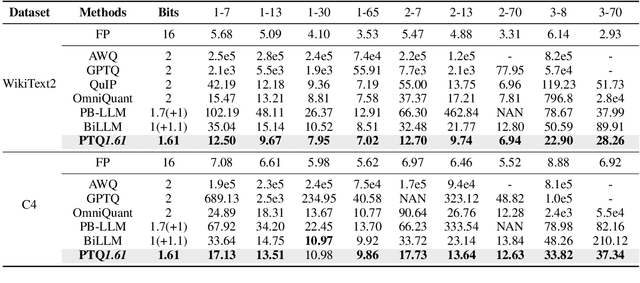
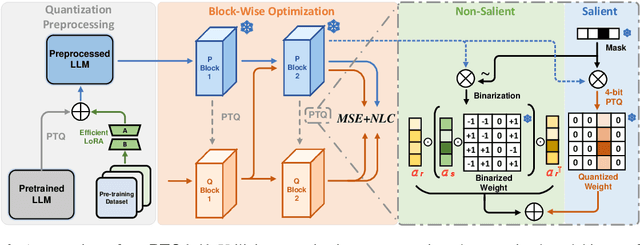
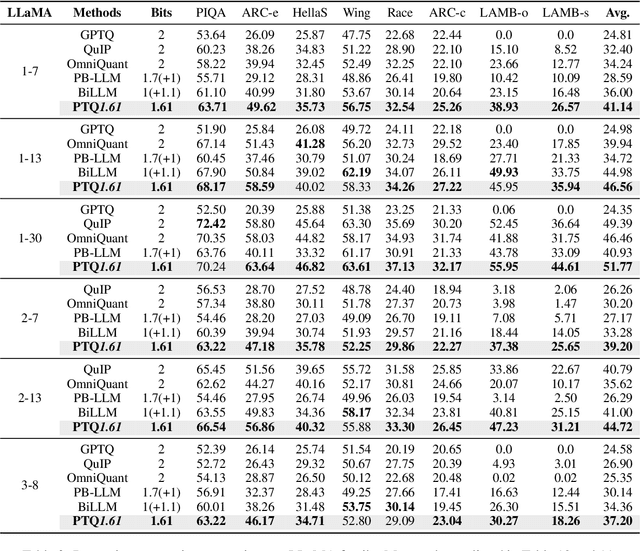
Abstract:Large Language Models (LLMs) suffer severe performance degradation when facing extremely low-bit (sub 2-bit) quantization. Several existing sub 2-bit post-training quantization (PTQ) methods utilize a mix-precision scheme by leveraging an unstructured fine-grained mask to explicitly distinguish salient weights, while which introduces an extra 1-bit or more per weight. To explore the real limit of PTQ, we propose an extremely low-bit PTQ method called PTQ1.61, which enables weight quantization to 1.61-bit for the first time. Specifically, we first introduce a one-dimensional structured mask with negligibly additional 0.0002-bit per weight based on input activations from the perspective of reducing the upper bound of quantization error to allocate corresponding salient weight channels to 4-bit. For non-salient channels binarization, an efficient block-wise scaling factors optimization framework is then presented to take implicit row-wise correlations and angular biases into account. Different from prior works that concentrate on adjusting quantization methodologies, we further propose a novel paradigm called quantization preprocessing, where we argue that transforming the weight distribution of the pretrained model before quantization can alleviate the difficulty in per-channel extremely low-bit PTQ. Extensive experiments indicate our PTQ1.61 achieves state-of-the-art performance in extremely low-bit quantization. Codes are available at https://github.com/zjq0455/PTQ1.61.
Language Models as Continuous Self-Evolving Data Engineers
Dec 19, 2024Abstract:Large Language Models (LLMs) have demonstrated remarkable capabilities on various tasks, while the further evolvement is limited to the lack of high-quality training data. In addition, traditional training approaches rely too much on expert-labeled data, setting an upper limit on the performance of LLMs. To address this issue, we propose a novel paradigm that enables LLMs to train itself by autonomously generating, cleaning, reviewing, and annotating data with preference information, named LANCE. Our approach demonstrates that LLMs can serve as continuous self-evolving data engineers, significantly reducing the time and cost of the post-training data construction process. Through iterative fine-tuning on different variants of the Qwen2, we validate the effectiveness of LANCE across various tasks, showing that it can continuously improve model performance and maintain high-quality data generation. Across eight benchmark dimensions, LANCE resulted in an average score enhancement of 3.36 for Qwen2-7B and 2.70 for Qwen2-7B-Instruct. This training paradigm with autonomous data construction not only reduces the reliance on human experts or external models but also ensures that the data aligns with human values and preferences, paving the way for the development of future superintelligent systems that can exceed human capabilities.
Creating a Microstructure Latent Space with Rich Material Information for Multiphase Alloy Design
Sep 04, 2024Abstract:The intricate microstructure serves as the cornerstone for the composition/processing-structure-property (CPSP) connection in multiphase alloys. Traditional alloy design methods often overlook microstructural details, which diminishes the reliability and effectiveness of the outcomes. This study introduces an improved alloy design algorithm that integrates authentic microstructural information to establish precise CPSP relationships. The approach utilizes a deep-learning framework based on a variational autoencoder to map real microstructural data to a latent space, enabling the prediction of composition, processing steps, and material properties from the latent space vector. By integrating this deep learning model with a specific sampling strategy in the latent space, a novel, microstructure-centered algorithm for multiphase alloy design is developed. This algorithm is demonstrated through the design of a unified dual-phase steel, and the results are assessed at three performance levels. Moreover, an exploration into the latent vector space of the model highlights its seamless interpolation ability and its rich material information content. Notably, the current configuration of the latent space is particularly advantageous for alloy design, offering an exhaustive representation of microstructure, composition, processing, and property variations essential for multiphase alloys.
 Add to Chrome
Add to Chrome Add to Firefox
Add to Firefox Add to Edge
Add to Edge